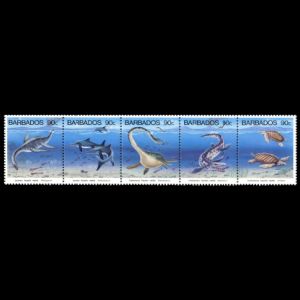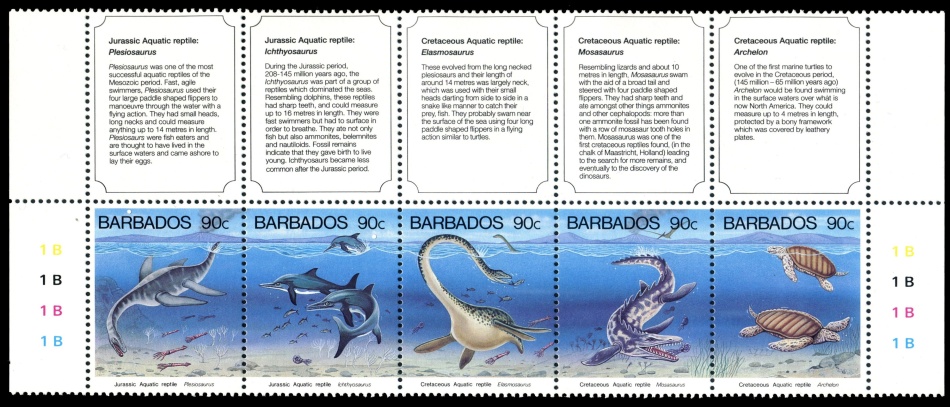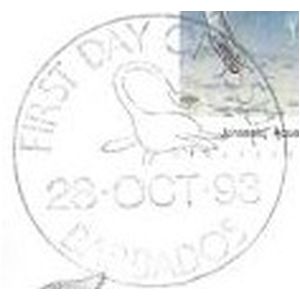the place where Paleontology and Paleoanthropology meets Philately
Barbados
Prehistoric animals on stamps and postmarks of Barbados
| << previous country | back to index | next country >> |
Contents:
- Country overview
- Philately of Barbados
- Official stamps of Barbados related to Paleontology
- Commemorative postmarks of Barbados related to Paleontology
- References
Barbados is a sovereign island country in the Lesser Antilles, in the Americas. It is 34 kilometers in length and up to 23 kilometers in width, covering an area of 432 square kilometres. It is situated in the western area of the North Atlantic and 100 kilometers east of the Windward Islands and the Caribbean Sea; therein, it is about 168 kilometers east of the islands of Saint Vincent and the Grenadines and 400 kilometers north-east of Trinidad and Tobago. Barbados is outside of the principal Atlantic hurricane belt.
The first Europeans to arrive on the island were probably the Portuguese in about the year 1500. In 1605 Sir Olave Leigh landed on the island and claimed it for King of England and Ireland James I. The first group of English settlers, about 30, arrived on the island in about 1624. More English settlers continued to arrive and by 1650 some 20,000 people had settled on the island.
In 1966, Barbados became an independent state and Commonwealth realm with the British Monarch as hereditary head of state, with the current population of ~280,000 people. Despite being classified as an Atlantic island, Barbados is considered to be a part of the Caribbean, where it is ranked as a leading tourist destination. [R1]
An independence issue was issued in 1966 which included stamps of the Hilton Hotel and cricketer Gary Sobers. [R2]. Since then, this island country has issued only a few sets a year. So far Barbados has issued only one set of Paleontology related stamps: "Prehistoric Aquatic Reptiles"
Official stamps of Barbados that related to Paleontology: dinosaurs and other prehistoric animals
| 28.10.1993 "Prehistoric Aquatic Reptiles" [1] | ||
 |
|
|
Notes:
[1] Issued in strips of all 5 stamps. For each stamp, gutter pairs with a label containing explanatory text about each animal exist. These labels were added in a separate row above or below the stamps.

Similar stamps were issued in Ascension Island and Saint Kitts in 1994.
Commemorative postmarks of Barbados related to Paleontology
Legend is here| 28.10.1993 "Prehistoric Aquatic Reptiles" [FDC] | ||
 |
|
|
References:
- [R1] Barbados: Wikipedia, WikiTravel, FlagCounter.
- [R2] Postal History and Philately of Barbados:
Wikipedia,
Links to official website of the Post Authority, stamp catalog and a list of new stamps of Barbados are here.
Acknowledgements:
Many thanks to Dr. Peter Voice from Department of Geological and Environmental Sciences, Western Michigan University, for reviewing the draft page and his very valuable comments.
| << previous country | back to index | next country >> |